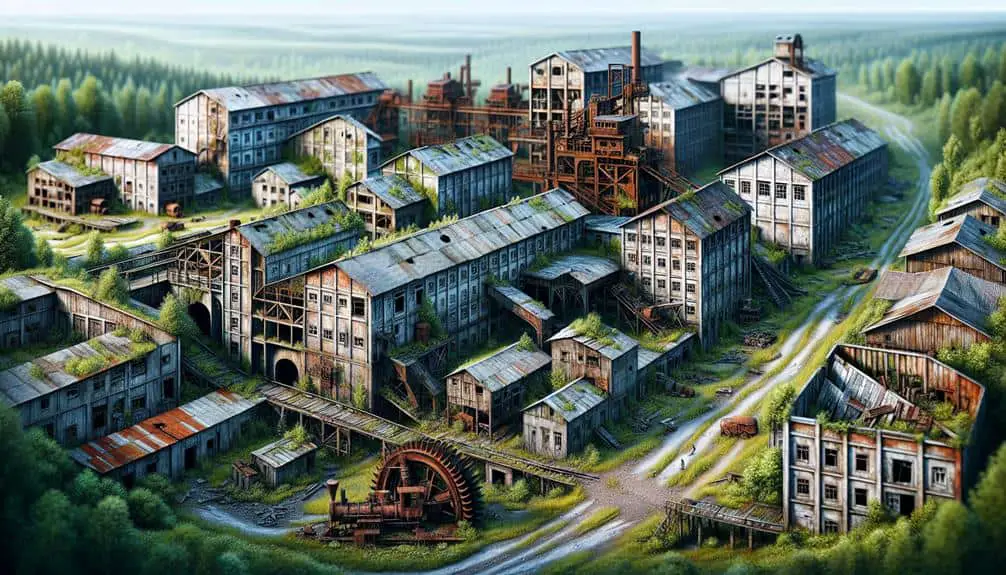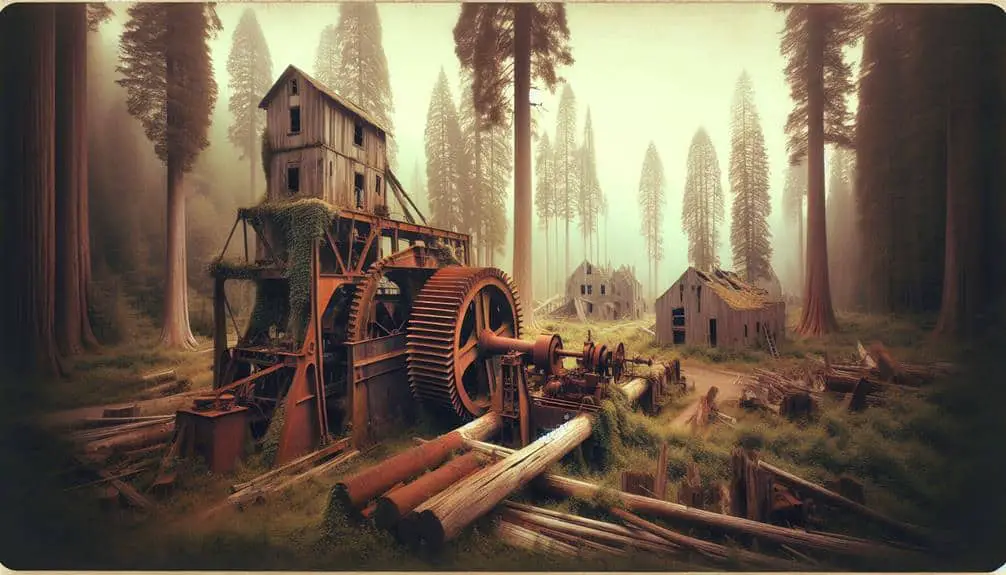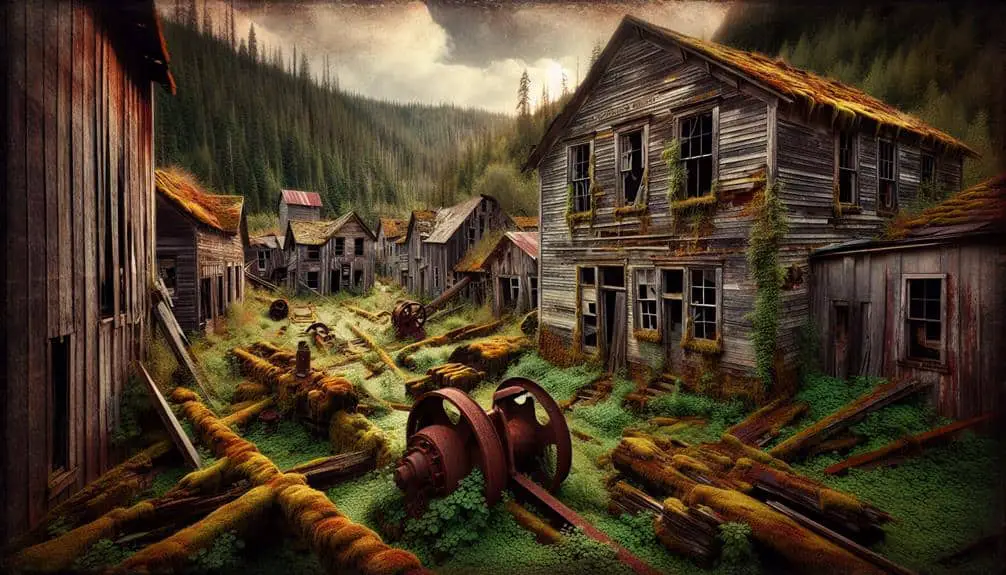The downfall of sawmill communities was triggered by economic shifts like labor shortages and market fluctuations. Changing demographics and urban migration impacted skilled labor availability. Physically demanding work deterred skilled workers, leading to unstable revenue streams. Environmental challenges from deforestation and climate change disrupted ecosystems and biodiversity. Technological advancements in the logging industry increased productivity but also decreased the need for labor. Declining lumber demand due to urbanization and import competition intensified the challenges. Social and demographic shifts like urban migration and changing family structures further destabilized these communities. Understanding these factors is essential to grasp the complexity of sawmill communities.
Key Points
- Labor shortage due to changing demographics and urban migration trends.
- Market fluctuations leading to unstable revenue streams and financial insecurity.
- Decline in demand for lumber from urbanization and import competition.
- Impact of environmental changes like deforestation and climate change on timber resources.
- Social and demographic shifts affecting community vitality and economic structures.
Economic Shifts Impacting Sawmills
The economic landscape underwent significant transformations, directly impacting the viability and sustainability of sawmills. Labor shortage and market fluctuations emerged as key challenges for these communities. Labor shortage, a result of changing demographics and urban migration trends, posed a significant obstacle for sawmills. With fewer skilled workers willing to engage in physically demanding labor, sawmills struggled to meet production demands efficiently.
Market fluctuations further exacerbated the situation. Sawmills found themselves at the mercy of unpredictable market forces, leading to unstable revenue streams and financial insecurity. Fluctuating demand for lumber products, influenced by factors such as housing market trends and international trade policies, created a volatile environment for sawmill owners and workers alike.
In managing these economic shifts, sawmill communities faced tough decisions regarding workforce management and operational strategies. The need to adapt to a changing labor market while also responding to market uncertainties required a delicate balancing act. Failure to address these challenges effectively contributed to the downfall of many sawmill communities, highlighting the critical importance of resilience and adaptability in the face of economic adversity.
Environmental Changes and Deforestation
Environmental changes and deforestation present additional challenges for sawmill communities already grappling with economic shifts, further complicating their path to sustainability and resilience. Climate change exacerbates the vulnerability of these communities by affecting the availability of timber resources and altering the natural habitats of various species. The resulting habitat loss can lead to a decrease in biodiversity, disrupting the delicate ecological balance essential for healthy forests.
Soil erosion is another critical consequence of deforestation in sawmill areas. Without adequate tree cover, soil is more susceptible to erosion, impacting water quality and agricultural productivity downstream. Reforestation efforts are vital to mitigate these effects and restore the ecological functions of the forests.
As sawmill communities navigate these environmental challenges, it's imperative to implement sustainable logging practices that prioritize long-term forest health. By integrating conservation strategies and promoting responsible land management, these communities can adapt to changing environmental conditions while fostering a more resilient ecosystem for future generations.
Technological Advancements in Logging Industry
Amidst the evolution of the logging industry, advancements in technology are revolutionizing the way sawmill communities operate and manage their resources. The impact of automation and the increased efficiency of machinery have greatly transformed the logging sector.
Here are five key aspects highlighting the technological advancements in the logging industry:
- Automated Logging Equipment: The introduction of automated machinery has boosted productivity levels and reduced the need for manual labor in sawmill operations.
- Remote Monitoring Systems: Sawmill communities can now remotely oversee their logging activities, leading to better resource management and cost efficiency.
- Data Analytics in Logging: Utilizing data analytics helps in predicting maintenance needs, optimizing production schedules, and making informed decisions for improved efficiency.
- GPS Technology: Integration of GPS technology in logging equipment enables precise tracking of timber extraction, enhancing operational accuracy.
- Energy-Efficient Machinery: Modern logging machinery is designed to be more energy-efficient, reducing overall operational costs and environmental impact.
These advancements not only streamline operations but also pave the way for sustainable practices within sawmill communities.
Decline in Demand for Lumber
As technological advancements continue to reshape the logging industry, a noticeable shift has emerged with the decline in demand for lumber. The effects of urbanization and rural exodus play a significant role in this trend. As populations increasingly gravitate towards urban centers, the need for new construction in rural areas diminishes, reducing the demand for lumber from sawmill communities.
Additionally, the impacts of global trade, particularly import competition, have intensified the challenges faced by these communities. Imported lumber often comes from regions with lower production costs, making it more affordable compared to domestically sourced lumber, further decreasing the demand for locally produced wood. This import competition has put pressure on sawmill communities, forcing them to adapt to changing market dynamics.
To address the decline in demand for lumber, these communities must explore diversification strategies and seek new opportunities in related industries to secure their sustainability in the face of these challenges.
Social and Demographic Shifts in Communities
Experiencing shifts in social dynamics and demographics, sawmill communities are undergoing transformations that impact their economic and cultural fabric. These changes are important to understanding the evolution of these once-thriving settlements:
- Cultural Assimilation: As new populations move into these areas, traditional cultural practices and beliefs may be altered or lost over time, leading to a blending of different cultural elements.
- Urban Migration: Younger generations are increasingly seeking opportunities in urban centers, leaving behind aging populations in sawmill communities and affecting the community's vitality.
- Changing Family Structures: The traditional family unit in these communities is evolving, with implications for social support systems and community cohesion.
- Economic Diversification: Communities are exploring new economic activities beyond lumber, impacting the traditional economic structure.
- Infrastructure Development: With demographic shifts, the need for updated infrastructure becomes apparent to meet the changing needs of the population.
These shifts highlight the complex interplay between social, demographic, and economic factors shaping the future of sawmill communities.
Frequently Asked Questions
How Did the Introduction of New Regulations and Policies Impact Sawmill Communities?
When new regulations and policies flooded in, it was like a tsunami hitting sawmill communities. Government intervention caused chaos, strangling economic growth. The economic downturn worsened as restrictions suffocated the once-thriving industry.
What Role Did Globalization Play in the Downfall of Sawmill Communities?
Globalization effects on local economies were substantial. Environmental concerns and market shifts resulted in the downfall of sawmill communities. Understanding the impact of these factors is essential in comprehending the challenges faced by these communities.
How Did the Rise of Alternative Building Materials Affect the Demand for Lumber and Contribute to the Decline of Sawmill Communities?
As the construction industry embraced alternative materials, lumber demand dwindled, causing economic shifts for sawmill communities. The rise of alternatives altered the landscape, challenging traditional practices and contributing to the decline.
What Impact Did Labor Disputes and Strikes Have on Sawmill Communities?
Labor disputes in sawmill communities created division, halted production, and strained relationships among workers. Strikes led to economic turmoil, impacting families and causing instability. The community impact of these conflicts was profound, reshaping the social fabric.
How Did Changes in Transportation and Infrastructure Affect the Sustainability of Sawmill Communities?
As transportation improved, sawmill communities faced economic shifts. The impact of technology on their sustainability was profound. For instance, the introduction of railroads reduced costs but also led to increased competition, challenging their existence.



